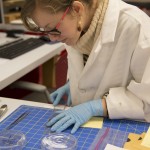First of all, you might be wondering. Why do conservation labs conduct photography?
A picture is worth a thousand words:
Photographs are the most descriptive way for conservators to accurately document physical changes made to an object during treatment.
In conservation, producing photographic documentation is a conservation professional’s ethical obligation. In conjunction with written documentation, the photographs help to more accurately and efficiently document the examination, scientific investigation, and treatment of special collection materials.
Afterwards, the photography becomes an important part of the treatment record for a rare object and it is permanently archived with the treatment report. This information is saved with the object in hopes of aiding future scholars and conservators in understanding an object’s aesthetic, conceptual, or physical historical characteristics. For more information on conservation treatment documentation, visit the Preservation Lab’s digital collection located here: http://digital.libraries.uc.edu/collections/preservation/.
…
Read More Read More
 at is it that you do, exactly?” is a question conservators are often asked when met for the first time.
at is it that you do, exactly?” is a question conservators are often asked when met for the first time.